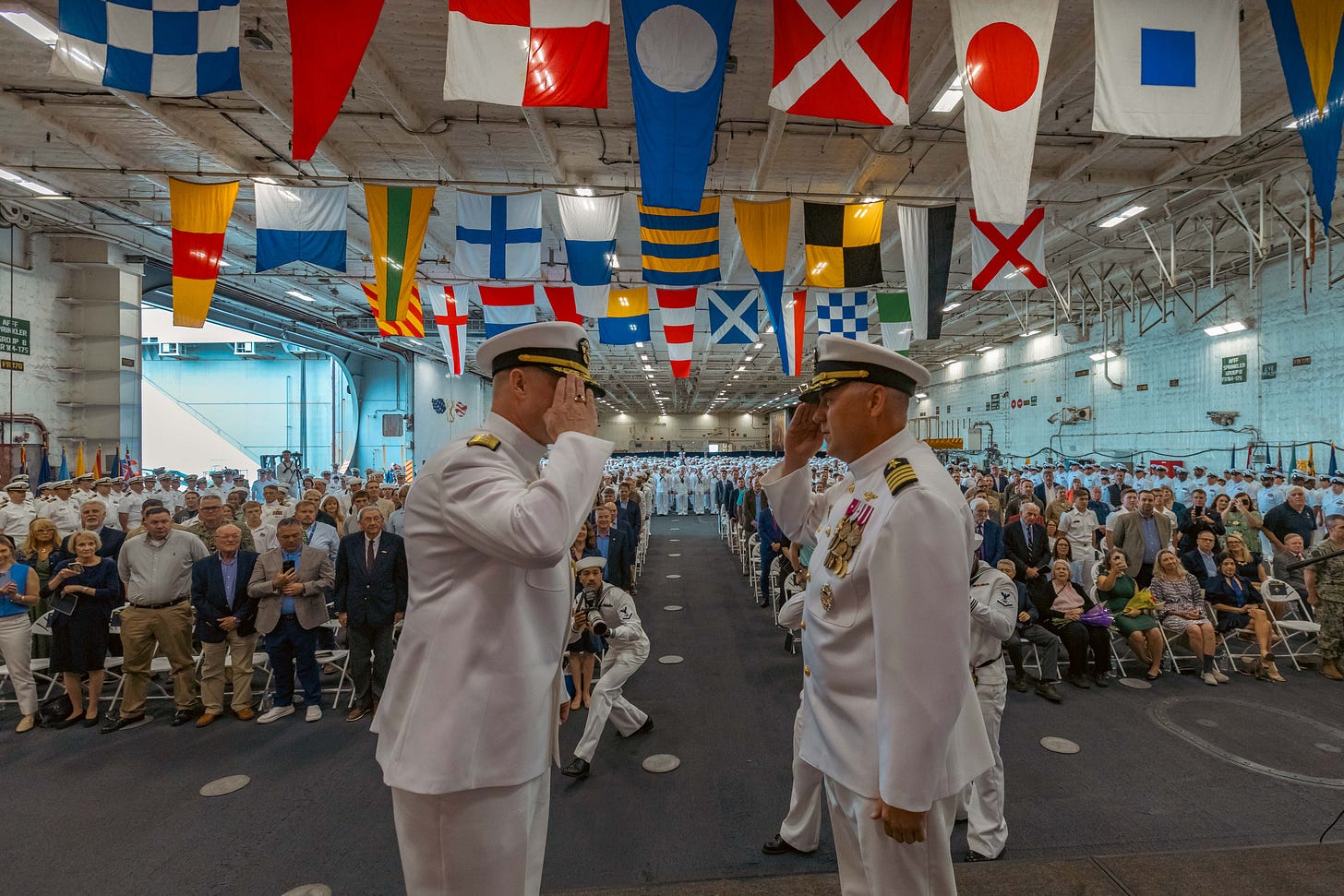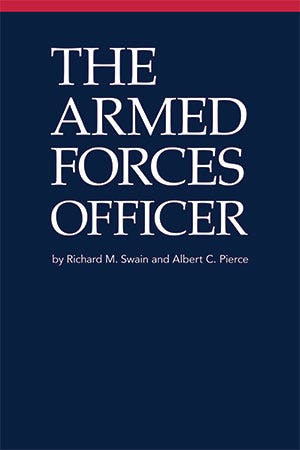Note: I typically write about topics focused on the intersection of social science and faith as they pertain to how we humans navigate the hardship and uncertainty of life. That will continue. Another important part of how we navigate a certain segment of life’s crucibles involves how we conceptualize, operate, and interact with the military. Why? Click here for an explanation. So, I’m exploring that once in a while via a ten-part series unpacking ideas from the book The Armed Forces Officer.
Below is part 6 of 10 (click here for all posts on this topic). As always, these are my views, and they do not necessarily represent the views of the U.S. Department of Defense or its components.
The Idea of Command
“Command” is one of those words that may evoke a number of different concepts and mental images: a person of authority, someone giving orders, a confident leader who gets things done. It’s a word that lends itself to stereotypes and caricatures, reflections that resemble reality yet exaggerate its subtle features.
And yet in the world of military leadership, “command” is a pivotal idea. It’s also one that wraps and gives shape to a few related ideas that are relevant to anyone who is in a position of authority. Those related ideas include authority itself along with responsibility, accountability, and character.
Authority
Citing official military doctrine, Richard Swain and Albert Pierce in the sixth chapter of The Armed Forces Officer state, “Command is ‘the authority that a commander in the armed forces lawfully exercises over subordinates by virtue of rank or assignment’” (p. 78). As such, we can think about command as being tied closely to the vesting of official authority in some person through legitimate means. Those legitimate means in the military have a variety of foundations including law and various regulations.
From a leadership perspective writ large, command is therefore associated with one of the key sources of power that allow any leader to be influential. Namely, command is what we might consider to be the apex of legitimate power, or power derived from one’s position or title.
This exists in civilian contexts too: People do what the boss says to do sometimes simply because he or she is the boss and has certain authority because of his or her formal position in the organization.
While less relevant to the idea of command, additional sources of leadership power include reward power (the ability to provide that which people value), coercive power (the ability to punish people, via firing or a bad performance review, for example), referent power (power derived from being liked or respected), and expert power (power stemming from one’s knowledge or skill).
In the military, command as a formal designation exists at multiple levels. For example, a Navy admiral might command an entire fleet. Within that fleet, there are multiple other commanders of subordinate units such as groups, squadrons, and individual ships (among many other relationships and organizations).
Regardless, a big part of command in the military is that there’s a single person who “owns” what goes on within a specific set of responsibilities or expectations. And if things go wrong within that set of responsibility, the commander is held accountable.
Another big part of military command is that it’s explicit. Although some parts of the military are a bit complicated, it’s generally the case that it’s clear who is in command—who is in charge. That’s one reason why we have ceremonies to mark a change in command. In addition to being an opportunity to celebrate the service and accomplishments of the person completing a command assignment, it’s also a public, unequivocal display of the new person in command.

Because command is a big and important idea, military leaders periodically articulate their own take on what it means. One example of such an explanation comes from now-retired Adm. Lisa Franchetti, who served as the U.S. Navy’s 33rd Chief of Naval Operations. In October 2024, she wrote in her “Charge of Command” memo:
Congratulations on your selection to serve in the position of highest honor and greatest responsibility in our Navy: Command. Your selection to be a Commanding Officer is based on your proven performance and comes with the expectation that you will lead with integrity, courage, and humility …
The world today is a more volatile and dangerous place that I can recall in the entirety of my 39 years of service. The threats to our Nation and our interests are real and growing, as is the potential for near-term crises and conflicts. View everything you do through a warfighting lens and be ready to fight and win in combat. On Day One, you assume absolute ownership for leading and building the great people, great leaders, and great teams that will deter our adversaries, respond effectively in crisis, and win decisively in war. As the Commanding Officer, it is your solemn responsibility to lead your team in combat or in support of combat, when called.
She goes on in the memo to describe a number of other important facets related to her vision of command. It’s a good example—for both military and civilian leaders—of setting a vision for a specific critical role in the organization. If you’re interested, download it below and read it.
Note: As of writing this in June 2025, President Trump nominated Adm. Daryl Caudle to be the next Chief of Naval Operations. If confirmed, Adm. Caudle may issue his own version of this document. At the same time, the ideas expressed in Adm. Franchetti’s Charge of Command are timely, relevant, and steeped in Navy tradition—and her memo provides a good example for my purposes here.
Responsibility
When laws, policies, or regulations give authority to a certain position or rank, a necessary corollary is a set of expectations regarding what a person in that position or holding that rank must do. That’s the essence of responsibility. When someone “takes responsibility,” he or she is acknowledging those expectations and accepting the duty to ensure they’re carried out.
One reason this concept is critical in military operations is that it allows for decentralized action.
It’s easy to characterize military organizations as large, slow-moving bureaucracies (and it’s sometimes true). Yet many aspects of military organization—particularly in those related to combat—are decentralized, with a commander providing the overall intent to subordinates (including subordinate commanders) who then are expected to accomplish the mission within reasonable bounds of legality and prudence.
Even when not engaged in combat, Navy ships and submarines in particular often operate somewhat independently, making the notion of command and responsibility all the more important.
One phrase I learned early in my Navy career is that “you can delegate authority, but you can never delegate responsibility.” I can empower someone to go do something, but I’m still bound by the expectation to ensure it actually gets done.
Accountability
A person can have the authority to do something and the responsibility to ensure it gets done. But what if the person doesn’t get it done or otherwise fails to meet the expectations of his or her position? That’s when accountability matters.
In the words of Swain and Pierce, “Accountability involves accepting the consequences for the outcomes of action or inaction in circumstances for which one bears responsibility—whether it results from individual action, inaction, or inattention” (p.78). This part of command can be rather unforgiving, yet it makes sense when you consider the amount of latitude provided to military commanders in most circumstances plus the high stakes of their decisions.
Accountability, therefore, provides a check on the authority and responsibility of command. The organization’s structure gives you power and a set of expectations about what to do with that power; if you don’t use that power well or otherwise fail to meet expectations, then you’ll have to face the consequences. In the military, those consequences can include various forms of discipline, removal from command, and more.
Character
Swain and Pierce conclude their discussion of command with a few notes on character, referring to the values and qualities that commanders exhibit through their actions and decisions. The degree to which a commander’s character displays virtue is itself a source of authority, as most people follow others whom they admire and respect.
It’s also true, as the authors note, that as one becomes more senior and the organizations they command become larger, character becomes increasingly important. Senior commanders cannot interact with every single person within their command simply because of time and numbers. They can, however, through their actions, decisions, and communications display qualities that earn trust and respect.
Character always matters.
Summary
Certainly the idea of command is one that’s much more common in the military than in civilian organizations. Military officers must know what command means and intentionally condition themselves to be ready when called upon to take such positions of authority with full understanding of the responsibility and accountability that the position entails.
Civilian leaders, I would also argue, can benefit from these concepts. Leaders everywhere who understand the scope of their authority, take responsibility, and accept accountability are likely to be ones who both get things done and get things done the right way.
Given the centrality of one’s character in making all of this come together, I find it helpful to consider development in these areas as a journey, one of continual honing and clarifying one’s values and direction, of striving to live a life of congruence between what one says and what one does. It seems that if one has an approach something like that, then one will be more prepared to command than those who live less intentionally.
And it’s one more reason why the unexamined life is risky. Leading others is serious business, and we are well-served by treating it as such.
Please note: The opinions and views expressed here belong solely to the author and do not necessarily reflect those of the Department of Defense (DoD) or its components. Any mention of commercial products or services does not imply DoD endorsement. Additionally, the presence of external hyperlinks does not signify DoD approval of the linked websites or their content, products, or services.
References and for further reading
All of my current posts about The Armed Forces Officer
The Armed Forces Officer by Richard M. Swain and Albert C. Pierce. Click here to download the book for free from National Defense University Press.
The Declaration of Independence
The Constitution of the United States
Code of Conduct for Members of the United States Armed Forces
Join the Navy! Click here for information



